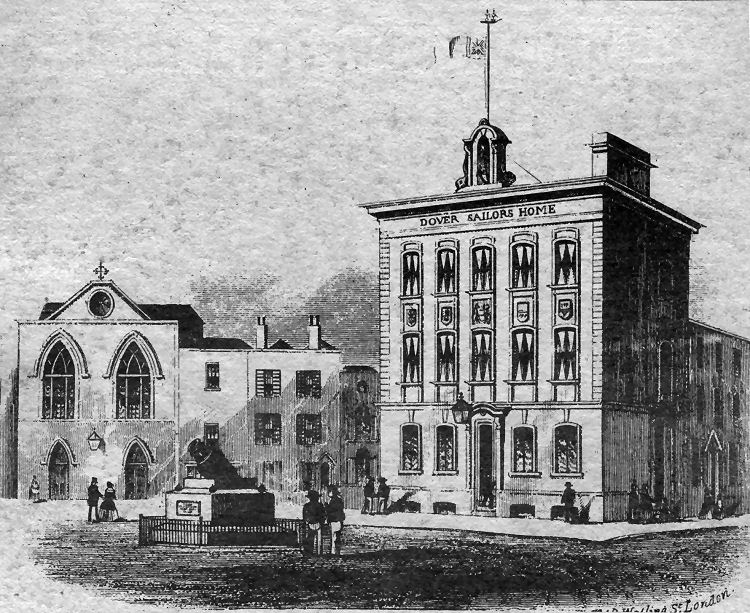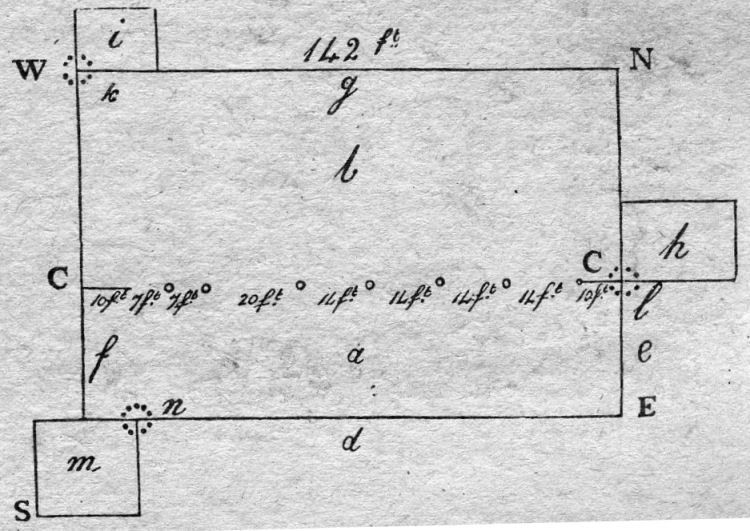Page Updated:- Sunday, 07 March, 2021. |
|||||
 Published in the Dover Express, 28 December, 1979. A PERAMBULATION OF THE TOWN, PORT AND FORTRESS. PART 45.
CHARTERS. The Maison Dieu having been regularly organised under the title of Master and Brethren, with "their men and lands," two years later, another royal charter, dated 1229, was granted, giving to them and their men, lands and tenements, freedom from suits of counties, hundreds, leets, and lawdays, from aids of sheriffs, view of frank pledge, and other imposts, affording practically the same liberties as those granted by Edward I to the Cinque Ports. By another charter, the King gave to the Master and Brethren a tithe of his share of the profits of the passage between Dover and the Continent; and by divers other charters, deeds, and grants, the Maison Dieu was greatly enriched, so as to provide funds for very extensive building, as well as to meet current expenses. To illustrate the fashion of the times, it may be mentioned that the same monarch, Henry III., founded at Ospringe, near Faversham, on the side of the London road, another Maison Dieu, dedicated to the Virgin Mary, in the year 1233, “for the entertainment of needy passengers and pilgrims.“ That house was vested in a Master, three regular Brethren, and two clerks, and continued its work until about a hundred years before the Reformation, when the Master and one of the Brethren dying of the plague, the other Brethren Bed, and the house becoming an escheat to the Crown, its revenues were subsequently granted to St. John’s College, Cambridge.
SOLDIERS’ AND SAILORS’ HOME. The Maison Dieu at Dover, in addition to affording shelter to poor passengers and pilgrims, also partook of the nature of a soldiers’ and sailors’ home. An ancient manuscript, relating to Dover Harbour, mentions the Hospital to have been built (among other things) for the relief of poor soldiers from beyond the sea, and that each soldier was allowed a subsistence for 14 days gratis. In addition to those who received casual shelter and relief, there appear to have been, in the 14th century, regular pensioners. In the reign of Edward III., it is recorded, in the Patent Rolls, that "Richard Waytewell is sent to the Maison Dieu of Dover, for his good services rendered to Queen Isabella, for maintenance for nothing for life," and there are other records of a similar character.
LATTER-DAY PILGRIMS. The Hospital does not seem to have continued to be as necessary in the 16th century, as it was when first founded, or it would be only reasonable to suppose that Henry VIII., when he dissolved the other monasteries, would have made provision for its revenues to be still used for the relief of the poor passengers, soldiers and sailors, according to the original intention. As he did nothing of the kind, he must have supposed that its work was finished, or was being continued by other agencies. In that, however, Henry VIII. seems to have been mistaken, and that, in his zeal for making a clean sweep of monasteries and nunneries, he destroyed a much-needed institution, and diverted to other purposes the revenues intended for the relief of needy persons landing at the port of Dover. In proof of this, it will be found that the Almshouse, either founded or resuscitated in the reign of Elizabeth, was deemed necessary to do work very similar to that which had been done by the Maison Dieu; and that that house was then considered to be needed, is clearly proved by the bequests made for its support. Here are a few examples of the sort of persons relieved by that Almshouse, after the suppression of the Maison Dieu: "Three saylers taken out of the gallies," ‘Men from New Castle who had lost their ship," “Breade, beare, and cheese for 84 pore soldiers, under Sir Horace Vere, landed from Flushing,“ a Blackamore and a Frenchman having my Lord Admiral’s pass,“ “Jeffrey Hales landed at Margate,“ "A trumpetter who came out of the great ship cast away in the Goodwin Sands.“ "Richard Pattison landed here out of Spain,“ "John Marlowe, a soldier bounde to Flushing," 12 Portingales that the Hollanders landed at Rye," and many other similar cases which prove that a successor to the Maison Dieu was then a public necessity at the port of Dover. This work was later taken over by Consuls of other nations when their nationals were stranded, and the Dover Sailors’ Home in the Pier District.

The old Dover National Sailors’ Home, pictured above, was erected in 1855 and for many years, until recent times, was an attractive feature of Blenheim Square, in Council House Street. Previously known as Red Pump Square because of a red pump which stood in the centre it was given the name Blenheim Square about the time the Sailors’ Home was founded because of the Russian mortar gun which was placed there following its presentation to the town by Captain W. H. Hall and the officers and crew of HMS Blenheim who claimed it after an action at Hango, in 1855. Near the home on the left is St. John’s Mariners’ Church which stood on a corner of Middle Row. Built by Mr Iggulden for a congregation of Wesleyan dissenters it passed into the bands of the Independents and was later used by the incumbent of Trinity Church before his church was completed. The home, chapel and church have all disappeared since the first World War,
Possibly, Henry VIII suppressed the Maison Dieu because he considered that the Master and Brethren had used their substance in too luxurious living, and in maintaining costly buildings which were out of character with the work they had to perform. The amount of valuable plate that was found there, and the buildings which existed at the time of the suppression, indicate a grand establishment which, perhaps, was in keeping with its position when the King was its patron, and when Sovereigns, prelates, and pilgrims of high degree received its hospitality, but out of character with the more humble task of the temporary lodging and feeding poor soldiers, sailors, and indigent passengers, which was practically all that was being done when Henry VIII, turned his royal searchlight on the doings of the Master and Brethren.
THE ANCIENT BUILDINGS. As to the buildings which composed the ancient Maison Dieu, there are two sources of information: (1) that incidentally given in the inventory taken at the time of the suppression; and (2) the old structures still left, together with historical records of some that have been destroyed. Among the apartments in the Maison Dieu mentioned in the inventory of 23rd January, 1534, are these, the church, the vestry, the great chamber called the Hoostrye, and a little chamber within it, Sir Peers chamber, the chamber over the water, and another little chamber in that, the Master’s chamber, the kitchen, the new kitchen, the infirmary, the garner, the Master's stables, the stables for the best cart horses, the second stable, the brewhouse, the bakehouse, and the barns. This list of departments, combined with what may still be seen of the Maison Dieu, and that which we know has been destroyed, conveys a rough idea of the great extent of the establishment. It is the part called the Great Chamber or Hoostrye that still remains, and is now called the Maison Dieu Hall (marked “a“ on the ground plan). The floor of this hall was several feet lower than it is at the present time, and it was lighted on the south-east side by seven fine windows, each 12ft. wide, having exactly the same tracery as the six there now, except that the original windows were about 2ft. deeper than the present ones. The seventh window was built up when the south-western tower was added at a later date. This hall is 142ft. long and 36ft. broad, and the height of the walls is 47ft. Externally, the windows, which are at equal distances apart, have between them massive buttresses rising to the top of the wall, each being surmounted with very curious grotesque figures.

|
|||||
|
If anyone should have any a better picture than any on this page, or think I should add one they have, please email me at the following address:-
|
|||||
| LAST PAGE |
|
MENU PAGE |
|
NEXT PAGE | |